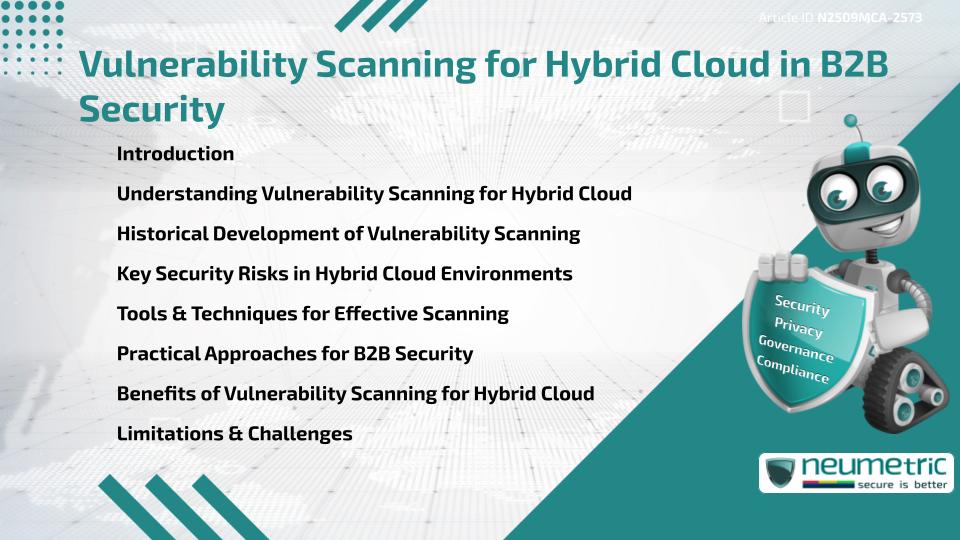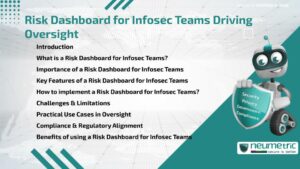Table of Contents
ToggleIntroduction
Vulnerability scanning for hybrid cloud has become a cornerstone of modern B2B security practices. A hybrid cloud, which combines private & public cloud resources, offers flexibility but introduces unique Risks. Effective scanning ensures that Potential Threats, misconfigurations & weaknesses are identified before attackers exploit them. This article examines the history, Risks, tools, benefits & limitations of Vulnerability scanning for hybrid cloud environments within the context of B2B security.
Understanding Vulnerability Scanning for Hybrid Cloud
Vulnerability scanning for hybrid cloud involves automated processes that detect & assess security flaws across both on-premises & cloud-based systems. In hybrid environments, data moves between public & private infrastructures, making consistent Security Monitoring essential. Scanning helps Organisations identify outdated software, weak Access Controls & insecure configurations across diverse platforms.
Historical Development of Vulnerability Scanning
The concept of Vulnerability scanning emerged in the late 1990s as businesses moved online & Cyber Threats increased. Early tools were limited, focusing mainly on network ports & known Vulnerabilities. Over time, scanning evolved into comprehensive platforms that assess applications, cloud workloads & endpoints. The shift to hybrid cloud accelerated demand for specialized solutions capable of addressing distributed & dynamic architectures.
Key Security Risks in Hybrid Cloud Environments
Hybrid cloud introduces several Risks that make Vulnerability scanning indispensable:
- Data Exposure: Sensitive Information may be inadvertently stored in insecure environments.
- Misconfigurations: Complex setups often result in weak access rules or excessive permissions.
- Third Party Risks: Partner integrations expand the attack surface.
- Compliance Violations: Misaligned practices can breach frameworks such as GDPR or HIPAA (source).
Tools & Techniques for Effective Scanning
Modern Vulnerability scanning for hybrid cloud uses specialized tools & techniques:
- Agent-Based Scanning: Installs lightweight agents on endpoints to detect issues in real time.
- Agentless Scanning: Evaluates cloud environments without installing software.
- Container Security: Ensures containerized applications remain hardened against attacks.
- Continuous Monitoring: Provides real-time detection rather than periodic checks.
Practical Approaches for B2B Security
To apply Vulnerability scanning effectively, B2B Organisations should:
- Adopt a Risk-Based Approach: prioritise critical Vulnerabilities that impact Business Continuity.
- Integrate with CI/CD Pipelines: Ensure secure software development practices.
- Leverage Automation: Reduce human error & scale across hybrid systems.
- Regular Reporting: Provide transparency for partners & regulators.
These practices enable Organisations to maintain strong security while supporting hybrid cloud flexibility.
Benefits of Vulnerability Scanning for Hybrid Cloud
Implementing scanning provides tangible advantages:
- Proactively identifies security weaknesses.
- Enhances Regulatory Compliance.
- Builds trust among B2B partners.
- Reduces the Risk of costly breaches.
- Improves overall system resilience.
Limitations & Challenges
Despite its benefits, Vulnerability scanning for hybrid cloud faces obstacles:
- False Positives: Automated tools may flag non-issues.
- Resource Intensity: Continuous scanning requires infrastructure investment.
- Skill Gaps: Specialized expertise is needed to interpret scan results.
- Complex Architectures: Hybrid environments can be difficult to assess comprehensively.
Takeaways
Vulnerability scanning for hybrid cloud in B2B security is no longer optional. By adopting the right tools & strategies, businesses can mitigate Risks, ensure compliance & strengthen their partnerships in the digital economy.
FAQ
What is Vulnerability scanning for hybrid cloud?
It is the process of detecting & evaluating security flaws across private & public cloud systems that make up a hybrid cloud.
Why is Vulnerability scanning essential in B2B security?
It helps prevent breaches, ensures compliance with standards & strengthens trust between business partners.
What Risks does a hybrid cloud face?
Risks include data exposure, misconfigurations, compliance violations & Vulnerabilities from Third Party integrations.
Which tools are commonly used for scanning hybrid cloud?
Tools from providers such as Tenable, Qualys & Rapid7 are widely used for hybrid Security Assessments.
How often should businesses scan hybrid environments?
Continuous Monitoring is recommended, but at a minimum, regular scans should be scheduled to align with compliance needs.
What are the limitations of Vulnerability scanning?
Challenges include false positives, resource requirements & the complexity of hybrid architectures.
Can scanning replace other Security Measures?
No, scanning should complement other practices such as encryption, Access Controls & Incident Response planning.
Need help for Security, Privacy, Governance & VAPT?
Neumetric provides organisations the necessary help to achieve their Cybersecurity, Compliance, Governance, Privacy, Certifications & Pentesting needs.
Organisations & Businesses, specifically those which provide SaaS & AI Solutions in the Fintech, BFSI & other regulated sectors, usually need a Cybersecurity Partner for meeting & maintaining the ongoing Security & Privacy needs & requirements of their Enterprise Clients & Privacy conscious Customers.
SOC 2, ISO 27001, ISO 42001, NIST, HIPAA, HECVAT, EU GDPR are some of the Frameworks that are served by Fusion – a SaaS, multimodular, multitenant, centralised, automated, Cybersecurity & Compliance Management system.
Neumetric also provides Expert Services for technical security which covers VAPT for Web Applications, APIs, iOS & Android Mobile Apps, Security Testing for AWS & other Cloud Environments & Cloud Infrastructure & other similar scopes.
Reach out to us by Email or filling out the Contact Form…





